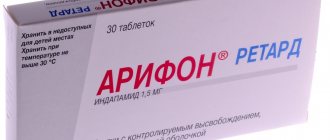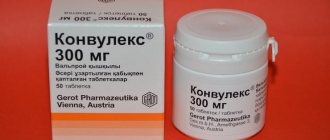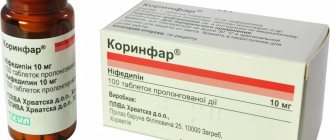In the fight against high blood pressure, the pharmaceutical drug Indapamide MV Stada is highly effective. It is sold in the form of tablets for oral administration and has a pronounced diuretic and antihypertensive effect. Indapamide should be used to normalize blood pressure (BP) strictly as prescribed by a cardiologist and following the recommendations described in the instructions for use of the pharmaceutical in question.
Composition and properties
The basis of Indapamide MV Stada is the active component - indapamide, and it is complemented by such auxiliary ingredients as:
- milk sugar;
- food emulsifier E572;
- Aerosil;
- hypromellose.
The medicine in question has pronounced diuretic and antihypertensive properties. The principle of action of the tablets is based on increasing the production of Na and Cl ions in urine, as well as, to a lesser extent, Mg and K. “Indapamide” blocks slow calcium channels, increases the elasticity of arterial walls and reduces peripheral vascular resistance. With proper and regular use of Indapamide, it will be possible to reduce the painful enlargement of the left ventricle of the heart and the sensitivity of the vascular wall to norepinephrine and AG2. As a result, a gradual drop in blood pressure occurs, and even when taking increased doses of the drug, a sharp decrease in blood pressure is not observed.
“Indapamide MV” tablets with the “Stada” prefix exhibit a persistent hypotensive effect on days 6-7 from the start of treatment and, due to their prolonged action, allow the medicine to be used once a day, since the decrease in pressure after drinking one tablet lasts for the whole day.
special instructions
If the antihypertensive effect is not sufficient within 4–8 weeks, it is possible to add an antihypertensive drug with a different mechanism of action to therapy. Further increase in the dose of Indapamide MV STADA is not recommended, since a significant increase in the antihypertensive effect is not observed, but the risk of side effects increases.
In the elderly, patients with hyperaldosteronism and patients receiving laxatives or cardiac glycosides, creatinine and potassium levels should be monitored.
All patients during drug therapy should regularly monitor plasma concentrations of magnesium, sodium and potassium ions (for possible electrolyte disturbances), concentrations of uric acid, glucose (very carefully in patients with diabetes, especially with concomitant hypokalemia) and residual nitrogen, as well as pH level. Determination of the plasma content of sodium ions is recommended before the start of treatment, potassium ions - a week after the start of therapy. The most careful monitoring is required in weakened patients, patients with heart failure, coronary heart disease, liver cirrhosis (especially if accompanied by ascites or edema), as well as patients receiving combination therapy. Patients who have an increased QT interval on their ECG or who are taking medications that can prolong the QT interval are also at increased risk.
When taking thiazide diuretics simultaneously, it is possible to reduce the excretion of calcium ions in the urine, which may result in minor and temporary hypercalcemia. Severe hypercalcemia when taking indapamide may indicate the presence of hyperparathyroidism, which was not previously identified. Before testing parathyroid function, the diuretic should be discontinued.
In patients with hepatic impairment, thiazide diuretics may cause the development of hepatic encephalopathy. Indapamide MV STADA in this case should be immediately discontinued.
Severe dehydration can cause the development of acute renal failure. Loss of water should be compensated, and renal function should be carefully monitored at the beginning of therapy.
Sulfonamide derivatives can aggravate the course of systemic lupus erythematosus. This information should also be taken into account when using indapamide.
With high plasma uric acid levels, Indapamide MV STADA may increase the incidence of gout attacks.
If doping control is carried out during therapy, it is possible to obtain a positive result.
Impact on the ability to drive vehicles and complex mechanisms
In some cases, especially at the beginning of therapy and when adding another antihypertensive drug, dizziness, drowsiness and some other reactions from the nervous system occur. Such patients should be especially careful when performing potentially hazardous work that requires attention and increased reaction speed.
Indications and contraindications
The drug is prescribed by a doctor for the treatment of hypertension.
According to the annotation, it is advisable to drink Indapamide if the following pathological conditions have been diagnosed:
- chronic form of decompensated myocardial dysfunction;
- average severity of hypertension.
Despite the high efficiency inherent in Indapamide MV Stada, not everyone is allowed to use it in the fight against high blood pressure. The drug is prohibited for patients under 18 years of age, as well as for women during pregnancy and breastfeeding. Antihypertensive medication should not be used if there is a reduced level of potassium in the blood, severe renal failure and hypersensitivity to any component of the tablets. For the pathologies listed below, the medication in question can be used, but it is extremely important to exercise special caution, otherwise taking Indapamide MV Stada will negatively affect the course of the disease and the patient’s health:
- impaired kidney and/or liver function;
- imbalance of water and salt;
- decompensated stage of diabetes mellitus;
- Burnett's syndrome;
- increased levels of uric acid in the blood.
Indapamide MV Stada
UNDESIRABLE DRUG COMBINATIONS
Lithium preparations:
with the simultaneous use of indapamide and lithium preparations, as well as when following a salt-free diet, an increase in the concentration of lithium in the blood plasma may be observed due to a decrease in its excretion, accompanied by the appearance of signs of lithium overdose. If necessary, diuretics can be used in combination with lithium preparations, and the dose of the drugs should be carefully selected, regularly monitoring the concentration of lithium in the blood plasma.
DRUG COMBINATIONS REQUIRING SPECIAL ATTENTION
Drugs that can cause polymorphic ventricular tachycardia of the “pirouette” type:
- class IA antiarrhythmic drugs (quinidine, hydroquinidine, disopyramide);
- class III antiarrhythmic drugs (amiodarone, sotalol, dofetilide, ibutilide);
- some neuroleptics: phenothiazines (chlorpromazine, cyamemazine, levomepromazine, thioridazine, trifluoroperazine), benzamides (amisulpride, sulpiride, sultopride, tiapride), butyrophenones (droperidol, haloperidol);
- others: bepridil, cisapride, difemanil, erythromycin (iv), halofantrine, mizolastine, pentamidine, sparfloxacin, moxifloxacin, astemizole, vincamine (iv).
Increased risk of ventricular arrhythmias, especially polymorphic ventricular tachycardia of the “pirouette” type (risk factor - hypokalemia).
The concentration of potassium in the blood plasma should be determined and, if necessary, adjusted before starting combination therapy with indapamide with the above drugs. It is necessary to monitor the patient’s clinical condition, monitor the content of blood plasma electrolytes, and ECG indicators.
In patients with hypokalemia, it is necessary to use drugs that do not cause polymorphic ventricular tachycardia of the “pirouette” type.
Nonsteroidal anti-inflammatory drugs (when administered systemically), including selective COX-2 inhibitors, high doses of acetylsalicylic acid (≥ 3 g/day):
the antihypertensive effect of indapamide may be reduced.
There is a risk of developing acute renal failure due to decreased glomerular filtration. Patients need to compensate for fluid loss and carefully monitor renal function at the beginning of treatment.
Angiotensin-converting enzyme (ACE) inhibitors:
Prescribing ACE inhibitors to patients with an initially reduced concentration of sodium ions in the blood (especially patients with renal artery stenosis) is accompanied by a risk of sudden arterial hypotension and/or acute renal failure.
Patients with arterial hypertension and possibly reduced sodium ion content in the blood plasma due to diuretics should:
- 3 days before starting treatment with an ACE inhibitor, stop taking diuretics. In the future, if necessary, taking a non-potassium-sparing diuretic can be resumed;
- or begin ACE inhibitor therapy with low doses, followed by a gradual increase in dose if necessary.
In chronic heart failure, treatment with ACE inhibitors should begin with the lowest doses, with a possible preliminary reduction in the doses of diuretics. In all cases, in the first weeks of taking ACE inhibitors in patients, it is necessary to monitor renal function (plasma creatinine content).
Other drugs that can cause hypokalemia: amphotericin B (iv), gluco- and mineralocorticosteroids (when administered systemically), tetracosactide, laxatives that stimulate intestinal motility:
increased risk of hypokalemia (additive effect).
Regular monitoring of potassium levels in the blood plasma is necessary and, if necessary, its correction. Particular attention should be paid to patients concomitantly receiving cardiac glycosides. It is recommended to use laxatives that do not stimulate intestinal motility.
Baclofen:
it is possible to enhance the antihypertensive effect.
Patients need to compensate for fluid loss and carefully monitor renal function at the beginning of treatment.
Cardiac glycosides:
hypokalemia enhances the toxic effect of cardiac glycosides.
With the simultaneous use of indapamide and cardiac glycosides, the content of potassium in the blood plasma, ECG parameters should be monitored, and, if necessary, therapy should be adjusted.
COMBINATION OF DRUGS REQUIRING ATTENTION
Potassium-sparing diuretics (amiloride, spironolactone, triamterene):
simultaneous administration of indapamide with potassium-sparing diuretics is advisable in some patients, however, the possibility of developing hypokalemia or hyperkalemia cannot be excluded (especially in patients with diabetes mellitus and renal failure).
It is necessary to monitor the concentration of potassium in the blood plasma, ECG indicators and, if necessary, adjust therapy.
Metformin
: functional renal failure, which can occur while taking diuretics, especially loop diuretics, with simultaneous administration of metformin increases the risk of developing lactic acidosis.
Metformin should not be used if the creatinine concentration exceeds 15 mg/L (135 µmol/L) in men and 12 mg/L (110 µmol/L) in women.
Iodinated contrast agents:
Dehydration of the body while taking diuretics increases the risk of developing acute renal failure, especially when using high doses of iodine-containing contrast agents.
Before using iodinated contrast agents, patients need to compensate for fluid loss.
Tricyclic antidepressants, antipsychotics (neuroleptics):
drugs of these classes enhance the antihypertensive effect of indapamide and increase the risk of orthostatic hypotension (additive effect).
Calcium salts:
with simultaneous administration, hypercalcemia may develop due to a decrease in the excretion of calcium ions by the kidneys.
Cyclosporine tacrolimus:
it is possible to increase the creatinine content in the blood plasma without changing the concentration of circulating cyclosporine, even with normal fluid and sodium ion levels.
Corticosteroids (mineral and glucocorticosteroids), tetracosactide (if administered systemically):
decreased antihypertensive effect (retention of fluid and sodium ions as a result of the action of corticosteroids).
Instructions for use
It is recommended to take the medicine in the morning with plenty of clean water.
If the doctor has not prescribed another therapeutic regimen, then you should take indapamide-based tablets for blood pressure, referring to the instructions. Thus, for the treatment of arterial hypertension, it is recommended to take 1 tablet, which, without chewing, is swallowed whole, washed down with a sufficient volume of purified water. It is better to take Indapamide MV Stada in the morning.
INDAPAMIDE (tablets)
and Ozone, because it costs 13 rubles.
The box contains 30 tablets. This drug comes in two dosages - 1.5 mg and 2.5 mg. Grandma used to take 1.5 mg, but now we buy 2.5. But if you need 1.5 mg, and you can’t find it at the pharmacy, then don’t take 2.5. These tablets are indivisible and breaking them is also very problematic. I buy this drug at the Zdorov pharmacy. ru by placing a pre-order on their website. And then I just come to the pharmacy and pick up my order without queuing. “In general, it produces a lot of budget drugs, not only Indapamide. This company is located in the city of Zhigulevsk, Samara region. All their contacts are listed here. The medicine is also so budget-friendly due to the fact that its box is quite simple, without any frills.
They say that Indapamide also has a diuretic effect, and my grandmother, by the way, has recently begun to notice this a little. We didn’t know this before, but when she also needed to take a separate diuretic, she began to notice that she was visiting this place too often, because we saw that Indapamide was having its effect.
It says here that the drug is given only by prescription, but this is not so - I had to buy indapamide a lot, but they never asked for a prescription. It also says how to store it, and that you should read the instructions before using this medicine.
When my grandmother drinks Indapamide and Enap, her blood pressure does not rise much. but if she, for example, gets too nervous, she can still crawl. Then you should take something that should quickly help lower your blood pressure, for example, Capoten. But you can’t have too much of it either, otherwise it can really lower your blood pressure, which can also be bad. when the pressure is too low, the person also does not feel the best.
So this medicine is very good, it helps with blood pressure very well, or rather, it helps blood pressure stay normal. Here is the date of manufacture and expiration date of this medicine - its expiration date is 4 years from the date of manufacture.
So, we take out the plate with pills from the box, and this is what it looks like - it also says what kind of medicine it is, the dosage and, of course, the manufacturer is indicated.
It also says here that these tablets are film-coated. This is what the tablets themselves look like, as you can see, they are so round and there is no way to separate them, they will simply crumble and that’s it. So follow the dosage. and if you were prescribed 1.5 mg, then take that. And then a couple of times, when my grandmother was still drinking 1.5 mg, I could not find this particular dosage in the pharmacy, and I had to take 2.5 mg. But then we just had these tablets lying around, because I had to look for 1.5 mg anyway.
Here are the instructions - they are small in size, but covered in small print. We are prescribed by a general practitioner, but whoever buys the medicine himself should definitely read the instructions.
In general, the recommendations from my grandmother and godmother-doctor are positive, we recommend it to everyone, and we give this drug an A.
Adverse events
The following negative effects may occur when using an antihypertensive drug:
- symptoms of inflammation of the pancreas;
- rapid weight loss;
- painful discomfort in the abdomen;
- attacks of nausea, severe vomiting;
- dryness in the mouth;
- insufficient difficulty in defecation or, conversely, frequent loose stools;
- nervousness, anxiety, sleep disturbances, prolonged depression, impotence, irritability;
- attacks of headache, excessive fatigue, weakness throughout the body;
- muscle spasm;
- suffocating cough;
- inflammation of the nasal mucosa, pharynx;
- decreased blood levels of potassium and sodium;
- rapid, pronounced heartbeat;
- decreased blood pressure;
- skin itching, rash, urticaria.
If adverse symptoms occur, it is prohibited to continue taking Indapamide MV Stada.
Side effects
- allergic reactions: often – maculopapular rash; uncommon – purpura; very rarely - itching, urticaria, hemorrhagic vasculitis, angioedema, Stevens-Johnson syndrome, toxic epidermal necrolysis;
- from the digestive system: infrequently – vomiting; rarely – dry mouth, nausea, constipation; very rarely - diarrhea, abdominal pain, anorexia, pancreatitis; in patients with liver failure - hepatic encephalopathy;
- from the urinary system: very rarely - polyuria, nocturia, renal failure, infections;
- from the respiratory system: pharyngitis, sinusitis, cough, rhinitis;
- from the central and peripheral nervous system: rarely - fatigue, asthenia, headache, tension, insomnia, drowsiness, paresthesia, anxiety, malaise, increased excitability, irritability, muscle spasms of the limbs, depression, vertigo;
- from the hematopoietic organs: very rarely - aplastic anemia, hemolytic anemia, leukopenia, agranulocytosis, bone marrow aplasia, thrombocytopenia;
- from the cardiovascular system: very rarely - palpitations, orthostatic hypotension, arrhythmia, changes in the electrocardiogram (ECG) characteristic of hypokalemia;
- laboratory indicators: decreased potassium levels and the development of hypokalemia (especially pronounced in patients at risk); very rarely - hypercalcemia, hyponatremia with hypovolemia and orthostatic hypotension, glucosuria, hypercreatininemia, increased blood urea nitrogen concentration; in individual cases – hyperglycemia, hyperuricemia; in case of simultaneous loss of chlorine ions - compensatory metabolic alkalosis;
- other: in individual cases - photosensitivity reactions, exacerbation of systemic lupus erythematosus.
Signs of overdose
Signs of excessive use of the drug are attacks of nausea and vomiting.
Ingestion of an excessive amount of indapamide leads to the development of renal coma, attacks of nausea, vomiting, digestive problems and a feeling of extreme fatigue. The victim finds it difficult to breathe and there is a strong drop in blood pressure. In case of overdose, you need to take a horizontal position so that the lower limbs are raised, rinse the stomach and take the sorbent.
Overdose
An overdose of indapamide may be manifested by the following symptoms: a marked decrease in blood pressure, water-electrolyte imbalance (hypokalemia, hyponatremia), nausea, vomiting, confusion, drowsiness, dizziness, lethargy, convulsions, respiratory depression, polyuria or oliguria up to anuria (due to hypovolemia ). Patients with cirrhosis of the liver may develop hepatic coma.
After taking an excessive dose of Indapamide MV STADA, the stomach should be lavaged. Subsequently, correction of water and electrolyte balance and symptomatic therapy are carried out. Indapamide does not have a specific antidote.





